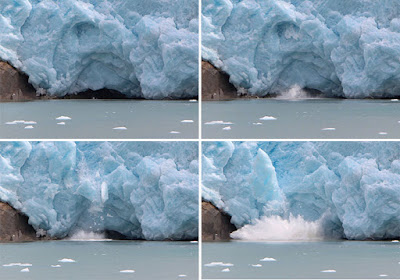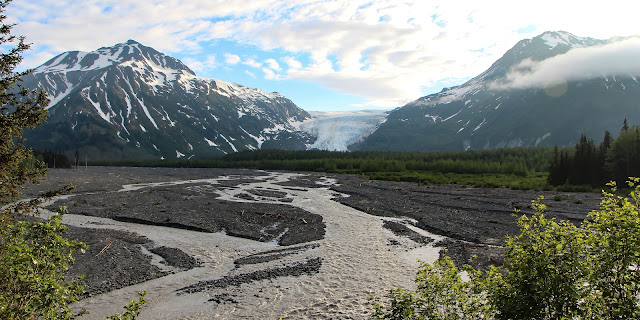What do you do when you’re in Seward? You could fish. We didn't.
 |
| We might have been the only non-fishing visitors |
You can visit the harbor. We did.
 |
| It's pretty on Resurrection Bay |
 |
| The tours travel in the National Park to see glaciers, scenery and wildlife |
The 1,046.9-square-mile Kenai Fjords National Park maintains the Harding Icefield, its outflowing glaciers and coastal fjords and islands on the Kenai Peninsula in south-central Alaska, west of Seward.
 |
| It's a vacation paradise with lodges, scenery and animals |
The Harding Icefield, source of at least 38 glaciers, is one of the largest ice fields in the United States.
 |
| One of the glaciers we visited (different tour routes visit different glaciers) |
The fjords are glacial valleys that have been submerged below sea level by a combination of rising sea levels and land subsidence.
 |
| Classic fjords: tall mountains and deep channels |
Kenai Fjords National Monument was initially designated under the Antiquities Act by President Jimmy Carter in 1978. The area became a National Park in 1980.
The Park protects the icefield, a narrow fringe of forested land between the mountains and the sea, and the deeply indented coastline.
The Park's landscape has been shaped by plate tectonics, with the Pacific Plate subducting beneath the North American Plate.
 |
| You see only part of the story |
The process lowered the elevation of the Kenai Mountains, gradually pulling glacial features down to the sea, which is at the same time rising. The fjords floors are from 600 to 1,000 feet below sea level.
Glaciers cover 51 percent Kenai Fjords National Park. Harding Icefield, which first formed about 23,000 years ago, receives 60 feet of snowfall per year.
The Park's largest glacier is Bear Glacier. The most accessible glacier, and the only portion of the park accessible by road, is Exit Glacier.
Kenai Fjords National Park's glaciers have retreated through the 20th century, exposing new lands to colonization by plant and animal life. Harsh conditions at higher altitudes limit tree growth above the treeline, creating an alpine ecosystem.
 |
| Even with abundant water, it is a tough landscape for plants |
Fortunately, the weather was better than the day before
where they had rain and rough seas. Unfortunately, there were low clouds that
didn’t clear.
Fortunately, it was clear at the Northwestern Glacier (it makes
its own weather).
 |
| The cold coming off the glacier often clears the skies on its face |
Wildlife
And, fortunately, we had lots of animal sightings. There were Sea Otters near the Seward Harbor ...
 |
| So cute |
We came upon a Gray Whale – very unusual in Seward in June (it should
have been in the Bering Sea).
We passed lots of humpbacks, doing multiple things, including diving ...
 |
| A blow and a fluke |
... fin slapping ...
 |
| Humpback Whales have very long pectoral fins |
... and, including about seven of them bubble net feeding
(or trying to; they were not well-coordinated).
 |
| Unexpected behavior |
Anyway, it's a good day when you see Humpback Whales.
 |
| A classic Alaskan scene |
We saw black-and-white Dall porpoise that look a lot like min-Orcas but are too fast to catch on the camera! But, we were able to photograph real Orcas (yay!) – a small group with several females ...
... and a baby ...
The islands were populated with hundreds (thousands?) of Steller Sea Lions ...
These guys are big (they are sometimes called Grizzlies of the sea") ...
 |
| We saw a variety of sizes |
... and plentiful ...
 |
| Too many to count (plus a juvenile Bald Eagle on the rock above them) |
Close to the glaciers, we saw Harbor Seals, both sitting on ice bergies ...
 |
| Watching us as we motored by |
... and swimming in the freezing water ...
 |
| They are so graceful in the water; not so much on land |
They like to stay on bergies near the cold, cold glacial water because Orcas don't venture that close to the glacier face.
 |
| How many do you see? Maybe 11 (one in the water) |
We saw Puffins ...
 |
| Two types of Puffins: Tufted, upper left and right; Horned, lower left |
Black-legged Kittiwakes ...
 |
| Huge colonies nest on the cliffs |
Common Murres ...
 |
| The nest on cliffs, often near the Puffins |
... and many other birds.
Plus, the sea was filled with Lion's Mane Jellies ...
 |
| The cold waters host lost of Jellies |
And,the shoreline was decorated with Barnacles and Ochre Sea Stars ...
 |
| Lots of critters clinging to the rocks |
Glaciers
But, the big draw was the glaciers, thick icy masses made from snow that has compressed over time.
 |
| Two tongues on a glacier flowing down |
A lot of snow, a cold climate and lack of wind are required for their creation.
 |
| Blue occurs because the compressed ice absorbs red wavelengths and scatters blue |
The Park has two type of glaciers: tidewater and alpine. Tidewater glaciers, of which the Park has five, flow from land to sea ...
 |
| Flowing into the ocean |
Alpine glaciers form in mountain basins, way up high. Exit Glacier, which forms a stream at its terminus, is an alpine glacier.
 |
| A look at a glacier's surface |
 |
| A nice vantage point |
... then cuts the engines so that we can hear the cracks and snaps the slowly moving "ice rivers" make as they creep toward the sea.
 |
| Glaciers are literally moving ice rivers |
And, we were lucky enough to see lots and lots of calving – the process in which big chunks of the glacier break off and fall into the ocean. This happens because of melting and/or erosion that causes a piece to break off.
 |
| One of the better ice falls |
 |
| Boom! |
Often, before you see the ice begin to fall, you hear loud booms. When the ice hits the water, it can create large waves. For that reason, the tour boat doesn't get too close. When the ice falls in the ocean, it forms icebergs (big), ice bergies (smaller) and brash (even smaller).
 |
| Still shrinking |
On the tour, which is narrated by a National Park Ranger, I learned a few things I didn’t know.
Like the different names for the ice that falls from the glaciers.
Or, the fact that the
ocean floor in this area dropped seven feet in the 1964 earthquake (think about
that: seven feet in just minutes!).
Plus, we saw real, frightening evidence of global warming as
the glaciers melt away at an alarming rate.
Trip date: June 3-July 20, 2013









No comments:
Post a Comment